Project Management for Business: Analyzing A2Z Construction Project
VerifiedAdded on 2020/06/04
|21
|5467
|52
Project
AI Summary
This project management assignment analyzes a construction project for A2Z Construction, which involves deciding between extending an existing building or buying and renovating a new one. The assignment covers project viability, success criteria, and the application of project management principles. It includes cash flow analysis, NPV calculations, and payback period analysis to determine the most viable project. The document explores project management systems, organizational structures, and the roles of key personnel, including project managers, finance controllers, and quality specialists. Task 3 provides a Gantt chart, network diagram, and PERT matrix, along with methods for performance measurement and project change control procedures. The analysis focuses on project planning, scheduling, estimating, cost control, and project change procedures. The conclusion summarizes the main findings and learning outcomes, emphasizing the practical implementation of project management theory.

1
Project Management for Business Assignment
Project Management for Business Assignment
Paraphrase This Document
Need a fresh take? Get an instant paraphrase of this document with our AI Paraphraser
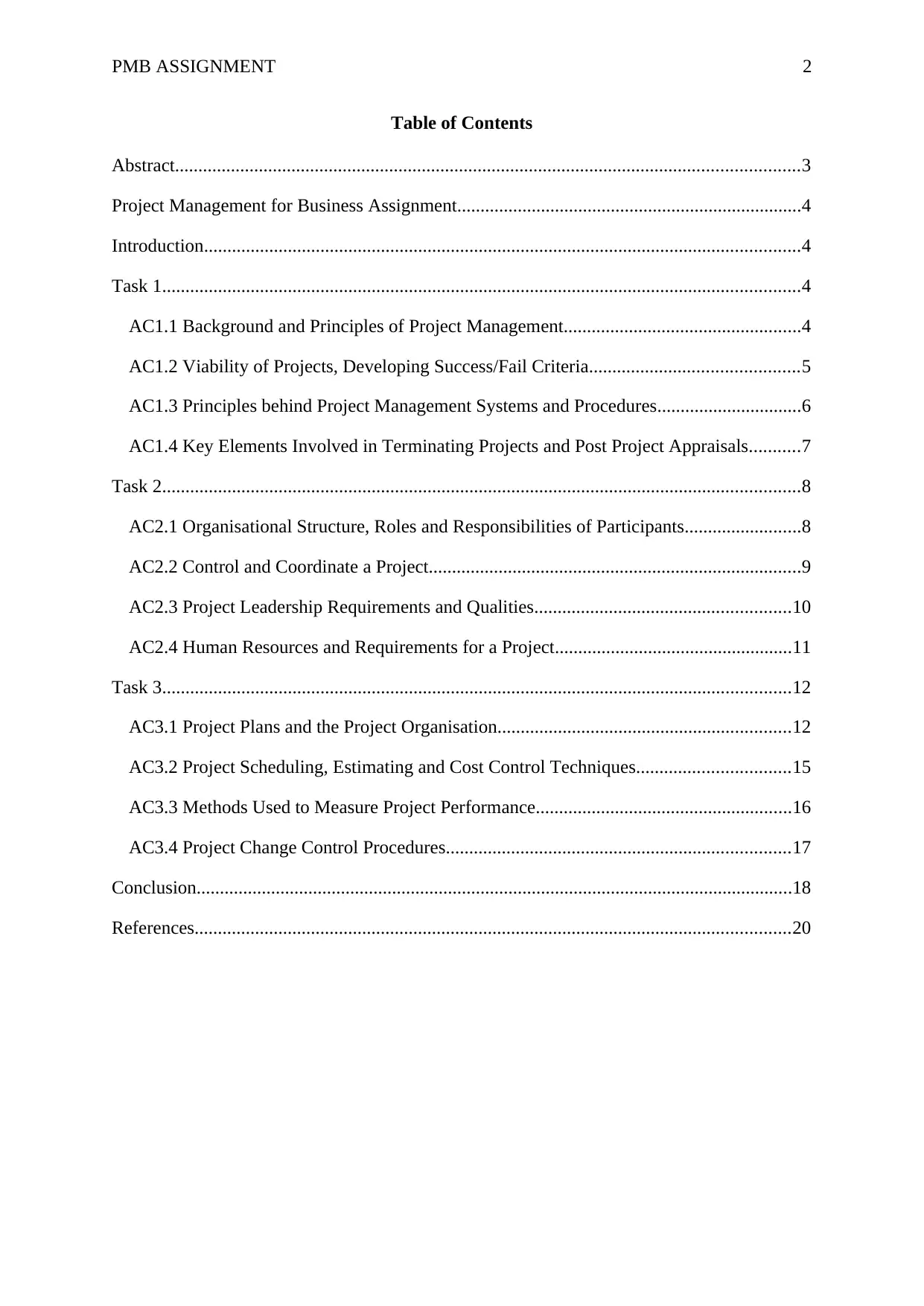
PMB ASSIGNMENT 2
Table of Contents
Abstract......................................................................................................................................3
Project Management for Business Assignment..........................................................................4
Introduction................................................................................................................................4
Task 1.........................................................................................................................................4
AC1.1 Background and Principles of Project Management...................................................4
AC1.2 Viability of Projects, Developing Success/Fail Criteria.............................................5
AC1.3 Principles behind Project Management Systems and Procedures...............................6
AC1.4 Key Elements Involved in Terminating Projects and Post Project Appraisals...........7
Task 2.........................................................................................................................................8
AC2.1 Organisational Structure, Roles and Responsibilities of Participants.........................8
AC2.2 Control and Coordinate a Project................................................................................9
AC2.3 Project Leadership Requirements and Qualities.......................................................10
AC2.4 Human Resources and Requirements for a Project...................................................11
Task 3.......................................................................................................................................12
AC3.1 Project Plans and the Project Organisation...............................................................12
AC3.2 Project Scheduling, Estimating and Cost Control Techniques.................................15
AC3.3 Methods Used to Measure Project Performance.......................................................16
AC3.4 Project Change Control Procedures..........................................................................17
Conclusion................................................................................................................................18
References................................................................................................................................20
Table of Contents
Abstract......................................................................................................................................3
Project Management for Business Assignment..........................................................................4
Introduction................................................................................................................................4
Task 1.........................................................................................................................................4
AC1.1 Background and Principles of Project Management...................................................4
AC1.2 Viability of Projects, Developing Success/Fail Criteria.............................................5
AC1.3 Principles behind Project Management Systems and Procedures...............................6
AC1.4 Key Elements Involved in Terminating Projects and Post Project Appraisals...........7
Task 2.........................................................................................................................................8
AC2.1 Organisational Structure, Roles and Responsibilities of Participants.........................8
AC2.2 Control and Coordinate a Project................................................................................9
AC2.3 Project Leadership Requirements and Qualities.......................................................10
AC2.4 Human Resources and Requirements for a Project...................................................11
Task 3.......................................................................................................................................12
AC3.1 Project Plans and the Project Organisation...............................................................12
AC3.2 Project Scheduling, Estimating and Cost Control Techniques.................................15
AC3.3 Methods Used to Measure Project Performance.......................................................16
AC3.4 Project Change Control Procedures..........................................................................17
Conclusion................................................................................................................................18
References................................................................................................................................20
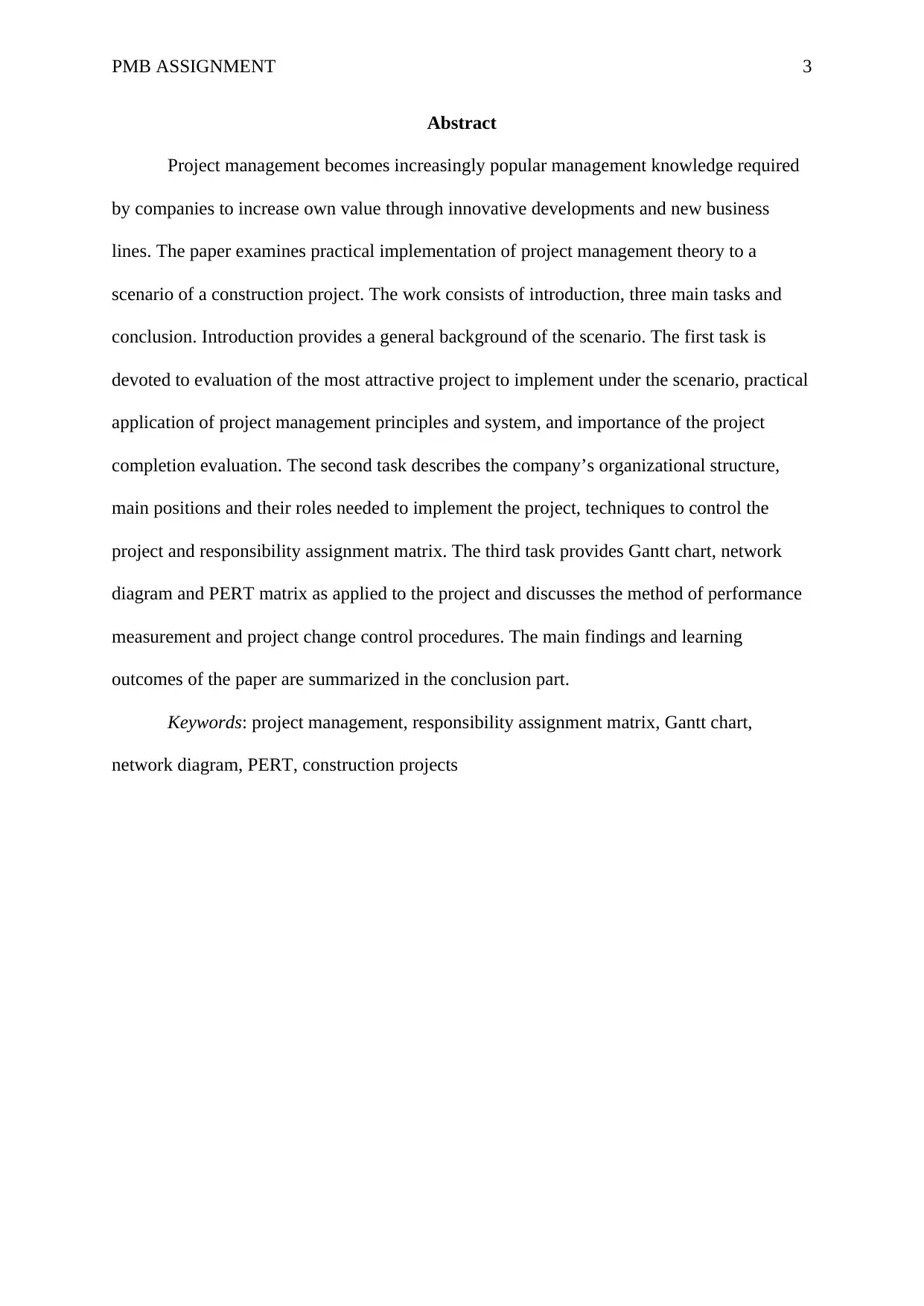
PMB ASSIGNMENT 3
Abstract
Project management becomes increasingly popular management knowledge required
by companies to increase own value through innovative developments and new business
lines. The paper examines practical implementation of project management theory to a
scenario of a construction project. The work consists of introduction, three main tasks and
conclusion. Introduction provides a general background of the scenario. The first task is
devoted to evaluation of the most attractive project to implement under the scenario, practical
application of project management principles and system, and importance of the project
completion evaluation. The second task describes the company’s organizational structure,
main positions and their roles needed to implement the project, techniques to control the
project and responsibility assignment matrix. The third task provides Gantt chart, network
diagram and PERT matrix as applied to the project and discusses the method of performance
measurement and project change control procedures. The main findings and learning
outcomes of the paper are summarized in the conclusion part.
Keywords: project management, responsibility assignment matrix, Gantt chart,
network diagram, PERT, construction projects
Abstract
Project management becomes increasingly popular management knowledge required
by companies to increase own value through innovative developments and new business
lines. The paper examines practical implementation of project management theory to a
scenario of a construction project. The work consists of introduction, three main tasks and
conclusion. Introduction provides a general background of the scenario. The first task is
devoted to evaluation of the most attractive project to implement under the scenario, practical
application of project management principles and system, and importance of the project
completion evaluation. The second task describes the company’s organizational structure,
main positions and their roles needed to implement the project, techniques to control the
project and responsibility assignment matrix. The third task provides Gantt chart, network
diagram and PERT matrix as applied to the project and discusses the method of performance
measurement and project change control procedures. The main findings and learning
outcomes of the paper are summarized in the conclusion part.
Keywords: project management, responsibility assignment matrix, Gantt chart,
network diagram, PERT, construction projects
⊘ This is a preview!⊘
Do you want full access?
Subscribe today to unlock all pages.

Trusted by 1+ million students worldwide
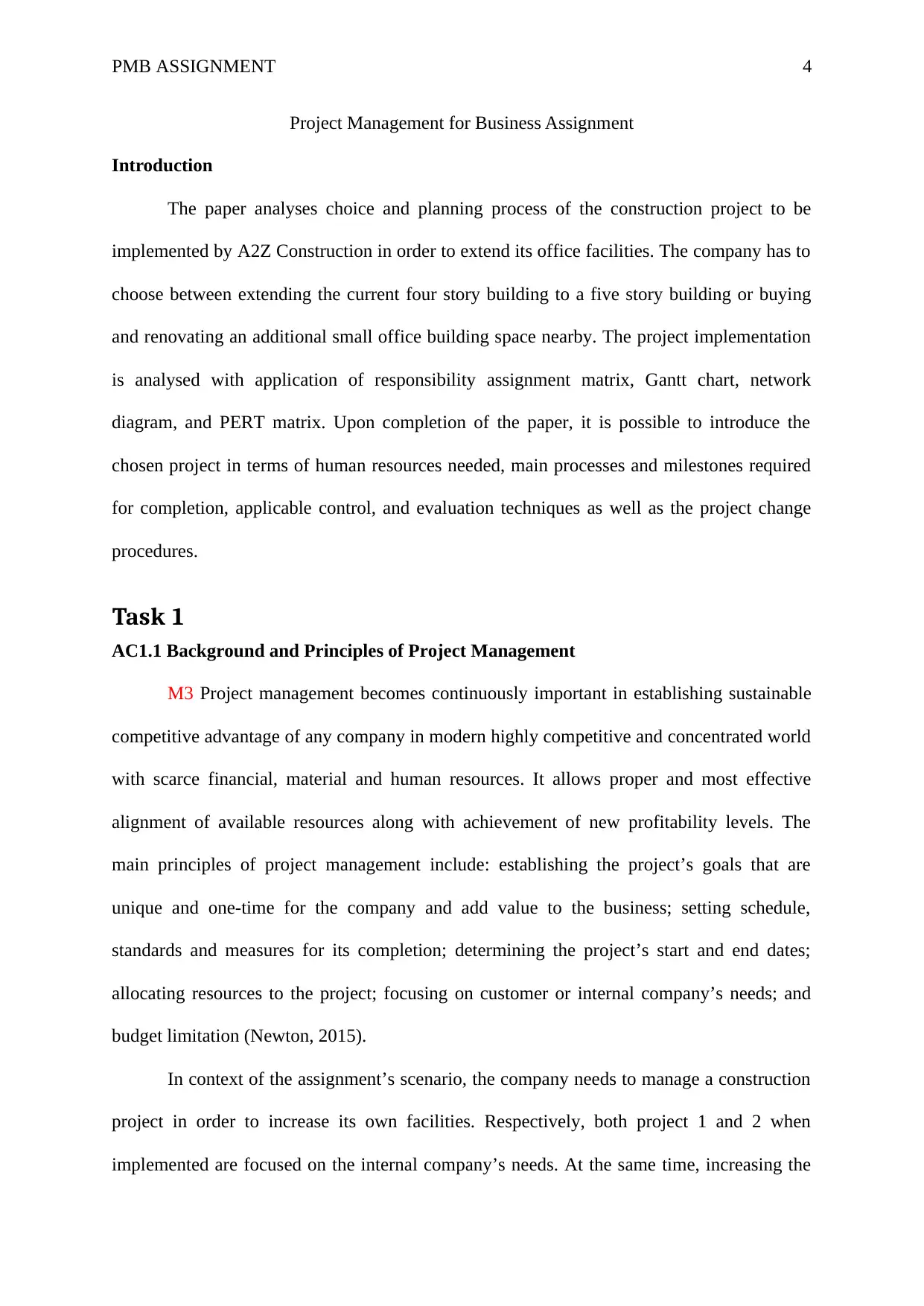
PMB ASSIGNMENT 4
Project Management for Business Assignment
Introduction
The paper analyses choice and planning process of the construction project to be
implemented by A2Z Construction in order to extend its office facilities. The company has to
choose between extending the current four story building to a five story building or buying
and renovating an additional small office building space nearby. The project implementation
is analysed with application of responsibility assignment matrix, Gantt chart, network
diagram, and PERT matrix. Upon completion of the paper, it is possible to introduce the
chosen project in terms of human resources needed, main processes and milestones required
for completion, applicable control, and evaluation techniques as well as the project change
procedures.
Task 1
AC1.1 Background and Principles of Project Management
M3 Project management becomes continuously important in establishing sustainable
competitive advantage of any company in modern highly competitive and concentrated world
with scarce financial, material and human resources. It allows proper and most effective
alignment of available resources along with achievement of new profitability levels. The
main principles of project management include: establishing the project’s goals that are
unique and one-time for the company and add value to the business; setting schedule,
standards and measures for its completion; determining the project’s start and end dates;
allocating resources to the project; focusing on customer or internal company’s needs; and
budget limitation (Newton, 2015).
In context of the assignment’s scenario, the company needs to manage a construction
project in order to increase its own facilities. Respectively, both project 1 and 2 when
implemented are focused on the internal company’s needs. At the same time, increasing the
Project Management for Business Assignment
Introduction
The paper analyses choice and planning process of the construction project to be
implemented by A2Z Construction in order to extend its office facilities. The company has to
choose between extending the current four story building to a five story building or buying
and renovating an additional small office building space nearby. The project implementation
is analysed with application of responsibility assignment matrix, Gantt chart, network
diagram, and PERT matrix. Upon completion of the paper, it is possible to introduce the
chosen project in terms of human resources needed, main processes and milestones required
for completion, applicable control, and evaluation techniques as well as the project change
procedures.
Task 1
AC1.1 Background and Principles of Project Management
M3 Project management becomes continuously important in establishing sustainable
competitive advantage of any company in modern highly competitive and concentrated world
with scarce financial, material and human resources. It allows proper and most effective
alignment of available resources along with achievement of new profitability levels. The
main principles of project management include: establishing the project’s goals that are
unique and one-time for the company and add value to the business; setting schedule,
standards and measures for its completion; determining the project’s start and end dates;
allocating resources to the project; focusing on customer or internal company’s needs; and
budget limitation (Newton, 2015).
In context of the assignment’s scenario, the company needs to manage a construction
project in order to increase its own facilities. Respectively, both project 1 and 2 when
implemented are focused on the internal company’s needs. At the same time, increasing the
Paraphrase This Document
Need a fresh take? Get an instant paraphrase of this document with our AI Paraphraser
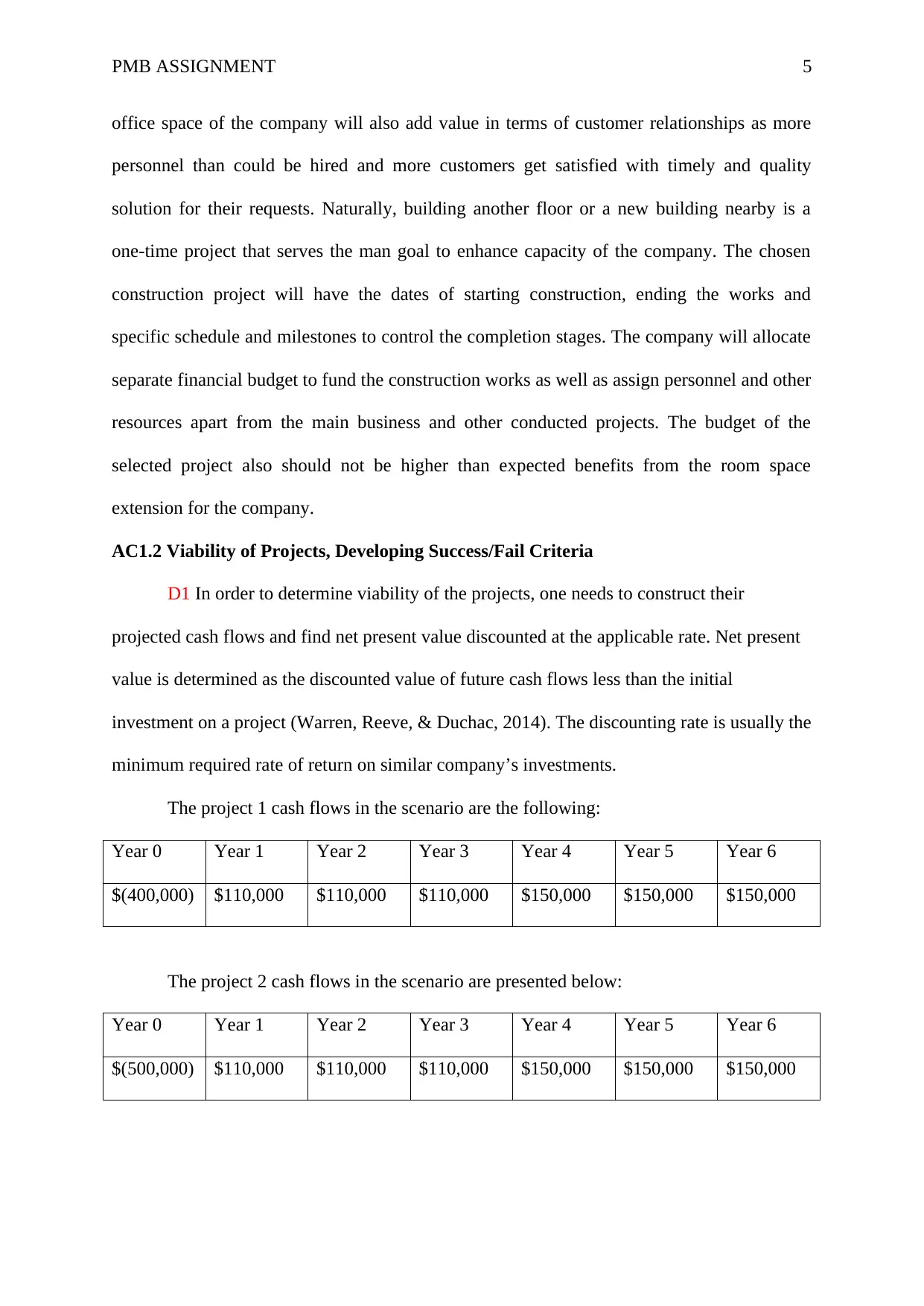
PMB ASSIGNMENT 5
office space of the company will also add value in terms of customer relationships as more
personnel than could be hired and more customers get satisfied with timely and quality
solution for their requests. Naturally, building another floor or a new building nearby is a
one-time project that serves the man goal to enhance capacity of the company. The chosen
construction project will have the dates of starting construction, ending the works and
specific schedule and milestones to control the completion stages. The company will allocate
separate financial budget to fund the construction works as well as assign personnel and other
resources apart from the main business and other conducted projects. The budget of the
selected project also should not be higher than expected benefits from the room space
extension for the company.
AC1.2 Viability of Projects, Developing Success/Fail Criteria
D1 In order to determine viability of the projects, one needs to construct their
projected cash flows and find net present value discounted at the applicable rate. Net present
value is determined as the discounted value of future cash flows less than the initial
investment on a project (Warren, Reeve, & Duchac, 2014). The discounting rate is usually the
minimum required rate of return on similar company’s investments.
The project 1 cash flows in the scenario are the following:
Year 0 Year 1 Year 2 Year 3 Year 4 Year 5 Year 6
$(400,000) $110,000 $110,000 $110,000 $150,000 $150,000 $150,000
The project 2 cash flows in the scenario are presented below:
Year 0 Year 1 Year 2 Year 3 Year 4 Year 5 Year 6
$(500,000) $110,000 $110,000 $110,000 $150,000 $150,000 $150,000
office space of the company will also add value in terms of customer relationships as more
personnel than could be hired and more customers get satisfied with timely and quality
solution for their requests. Naturally, building another floor or a new building nearby is a
one-time project that serves the man goal to enhance capacity of the company. The chosen
construction project will have the dates of starting construction, ending the works and
specific schedule and milestones to control the completion stages. The company will allocate
separate financial budget to fund the construction works as well as assign personnel and other
resources apart from the main business and other conducted projects. The budget of the
selected project also should not be higher than expected benefits from the room space
extension for the company.
AC1.2 Viability of Projects, Developing Success/Fail Criteria
D1 In order to determine viability of the projects, one needs to construct their
projected cash flows and find net present value discounted at the applicable rate. Net present
value is determined as the discounted value of future cash flows less than the initial
investment on a project (Warren, Reeve, & Duchac, 2014). The discounting rate is usually the
minimum required rate of return on similar company’s investments.
The project 1 cash flows in the scenario are the following:
Year 0 Year 1 Year 2 Year 3 Year 4 Year 5 Year 6
$(400,000) $110,000 $110,000 $110,000 $150,000 $150,000 $150,000
The project 2 cash flows in the scenario are presented below:
Year 0 Year 1 Year 2 Year 3 Year 4 Year 5 Year 6
$(500,000) $110,000 $110,000 $110,000 $150,000 $150,000 $150,000
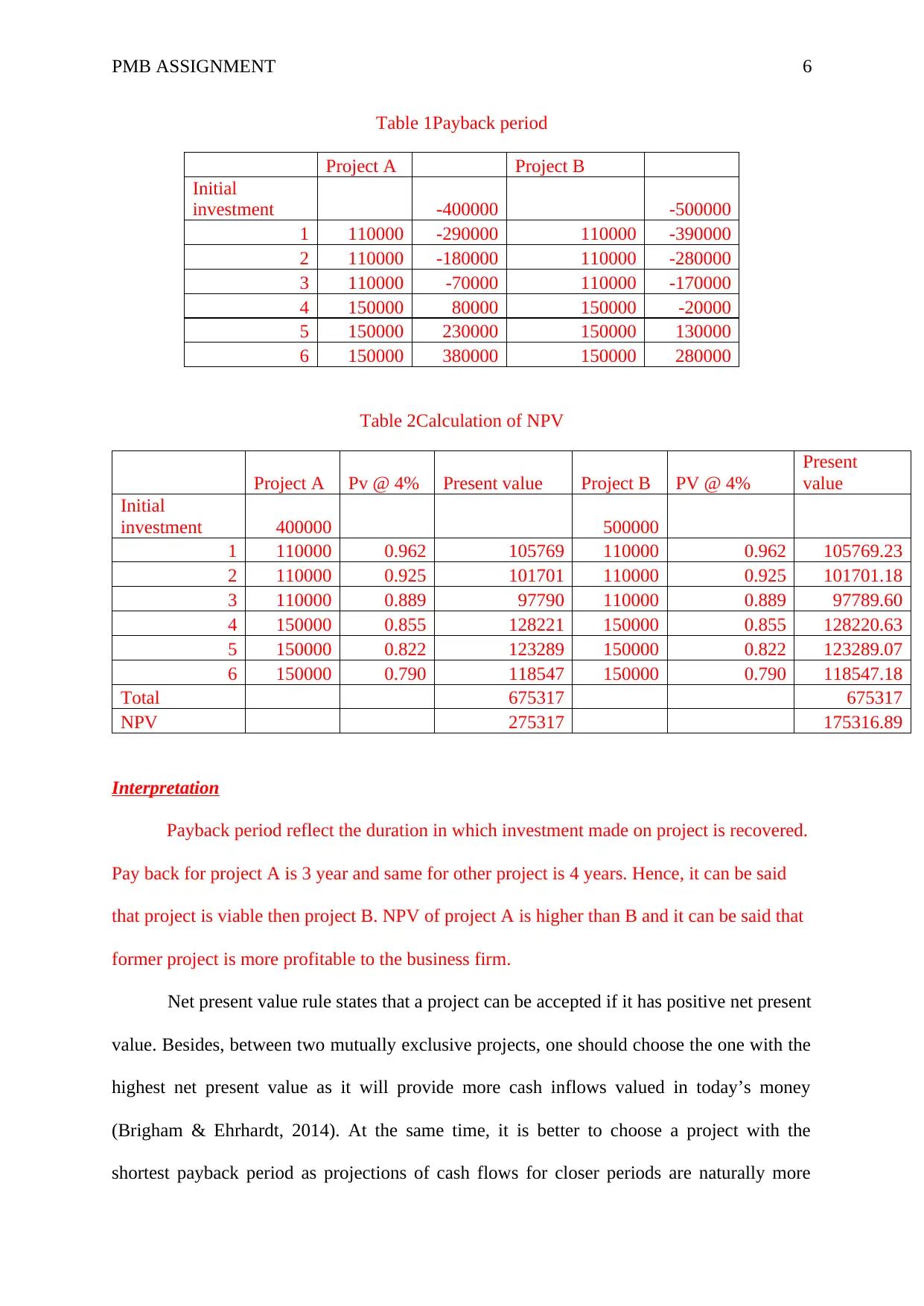
PMB ASSIGNMENT 6
Table 1Payback period
Project A Project B
Initial
investment -400000 -500000
1 110000 -290000 110000 -390000
2 110000 -180000 110000 -280000
3 110000 -70000 110000 -170000
4 150000 80000 150000 -20000
5 150000 230000 150000 130000
6 150000 380000 150000 280000
Table 2Calculation of NPV
Project A Pv @ 4% Present value Project B PV @ 4%
Present
value
Initial
investment 400000 500000
1 110000 0.962 105769 110000 0.962 105769.23
2 110000 0.925 101701 110000 0.925 101701.18
3 110000 0.889 97790 110000 0.889 97789.60
4 150000 0.855 128221 150000 0.855 128220.63
5 150000 0.822 123289 150000 0.822 123289.07
6 150000 0.790 118547 150000 0.790 118547.18
Total 675317 675317
NPV 275317 175316.89
Interpretation
Payback period reflect the duration in which investment made on project is recovered.
Pay back for project A is 3 year and same for other project is 4 years. Hence, it can be said
that project is viable then project B. NPV of project A is higher than B and it can be said that
former project is more profitable to the business firm.
Net present value rule states that a project can be accepted if it has positive net present
value. Besides, between two mutually exclusive projects, one should choose the one with the
highest net present value as it will provide more cash inflows valued in today’s money
(Brigham & Ehrhardt, 2014). At the same time, it is better to choose a project with the
shortest payback period as projections of cash flows for closer periods are naturally more
Table 1Payback period
Project A Project B
Initial
investment -400000 -500000
1 110000 -290000 110000 -390000
2 110000 -180000 110000 -280000
3 110000 -70000 110000 -170000
4 150000 80000 150000 -20000
5 150000 230000 150000 130000
6 150000 380000 150000 280000
Table 2Calculation of NPV
Project A Pv @ 4% Present value Project B PV @ 4%
Present
value
Initial
investment 400000 500000
1 110000 0.962 105769 110000 0.962 105769.23
2 110000 0.925 101701 110000 0.925 101701.18
3 110000 0.889 97790 110000 0.889 97789.60
4 150000 0.855 128221 150000 0.855 128220.63
5 150000 0.822 123289 150000 0.822 123289.07
6 150000 0.790 118547 150000 0.790 118547.18
Total 675317 675317
NPV 275317 175316.89
Interpretation
Payback period reflect the duration in which investment made on project is recovered.
Pay back for project A is 3 year and same for other project is 4 years. Hence, it can be said
that project is viable then project B. NPV of project A is higher than B and it can be said that
former project is more profitable to the business firm.
Net present value rule states that a project can be accepted if it has positive net present
value. Besides, between two mutually exclusive projects, one should choose the one with the
highest net present value as it will provide more cash inflows valued in today’s money
(Brigham & Ehrhardt, 2014). At the same time, it is better to choose a project with the
shortest payback period as projections of cash flows for closer periods are naturally more
⊘ This is a preview!⊘
Do you want full access?
Subscribe today to unlock all pages.

Trusted by 1+ million students worldwide
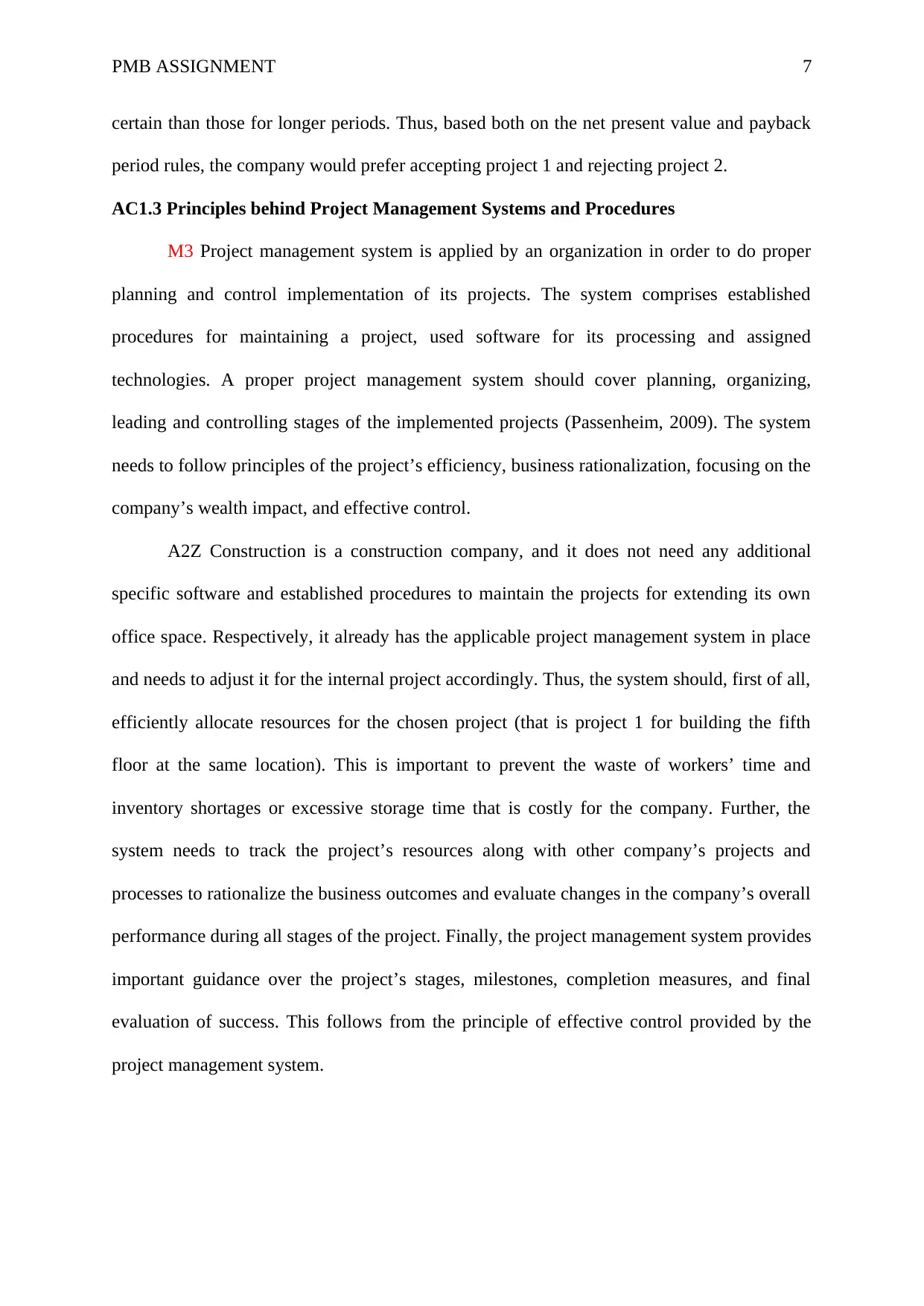
PMB ASSIGNMENT 7
certain than those for longer periods. Thus, based both on the net present value and payback
period rules, the company would prefer accepting project 1 and rejecting project 2.
AC1.3 Principles behind Project Management Systems and Procedures
M3 Project management system is applied by an organization in order to do proper
planning and control implementation of its projects. The system comprises established
procedures for maintaining a project, used software for its processing and assigned
technologies. A proper project management system should cover planning, organizing,
leading and controlling stages of the implemented projects (Passenheim, 2009). The system
needs to follow principles of the project’s efficiency, business rationalization, focusing on the
company’s wealth impact, and effective control.
A2Z Construction is a construction company, and it does not need any additional
specific software and established procedures to maintain the projects for extending its own
office space. Respectively, it already has the applicable project management system in place
and needs to adjust it for the internal project accordingly. Thus, the system should, first of all,
efficiently allocate resources for the chosen project (that is project 1 for building the fifth
floor at the same location). This is important to prevent the waste of workers’ time and
inventory shortages or excessive storage time that is costly for the company. Further, the
system needs to track the project’s resources along with other company’s projects and
processes to rationalize the business outcomes and evaluate changes in the company’s overall
performance during all stages of the project. Finally, the project management system provides
important guidance over the project’s stages, milestones, completion measures, and final
evaluation of success. This follows from the principle of effective control provided by the
project management system.
certain than those for longer periods. Thus, based both on the net present value and payback
period rules, the company would prefer accepting project 1 and rejecting project 2.
AC1.3 Principles behind Project Management Systems and Procedures
M3 Project management system is applied by an organization in order to do proper
planning and control implementation of its projects. The system comprises established
procedures for maintaining a project, used software for its processing and assigned
technologies. A proper project management system should cover planning, organizing,
leading and controlling stages of the implemented projects (Passenheim, 2009). The system
needs to follow principles of the project’s efficiency, business rationalization, focusing on the
company’s wealth impact, and effective control.
A2Z Construction is a construction company, and it does not need any additional
specific software and established procedures to maintain the projects for extending its own
office space. Respectively, it already has the applicable project management system in place
and needs to adjust it for the internal project accordingly. Thus, the system should, first of all,
efficiently allocate resources for the chosen project (that is project 1 for building the fifth
floor at the same location). This is important to prevent the waste of workers’ time and
inventory shortages or excessive storage time that is costly for the company. Further, the
system needs to track the project’s resources along with other company’s projects and
processes to rationalize the business outcomes and evaluate changes in the company’s overall
performance during all stages of the project. Finally, the project management system provides
important guidance over the project’s stages, milestones, completion measures, and final
evaluation of success. This follows from the principle of effective control provided by the
project management system.
Paraphrase This Document
Need a fresh take? Get an instant paraphrase of this document with our AI Paraphraser
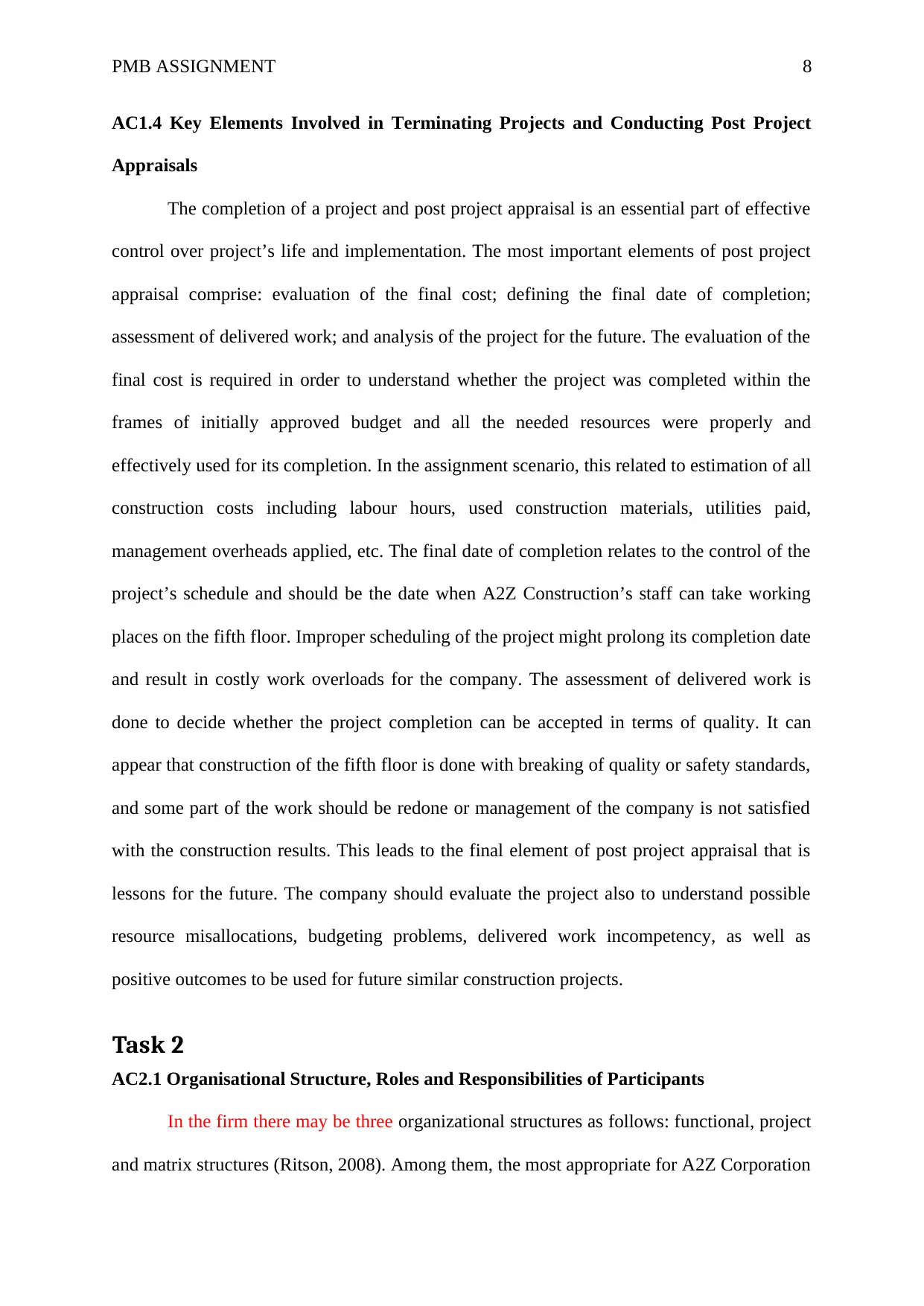
PMB ASSIGNMENT 8
AC1.4 Key Elements Involved in Terminating Projects and Conducting Post Project
Appraisals
The completion of a project and post project appraisal is an essential part of effective
control over project’s life and implementation. The most important elements of post project
appraisal comprise: evaluation of the final cost; defining the final date of completion;
assessment of delivered work; and analysis of the project for the future. The evaluation of the
final cost is required in order to understand whether the project was completed within the
frames of initially approved budget and all the needed resources were properly and
effectively used for its completion. In the assignment scenario, this related to estimation of all
construction costs including labour hours, used construction materials, utilities paid,
management overheads applied, etc. The final date of completion relates to the control of the
project’s schedule and should be the date when A2Z Construction’s staff can take working
places on the fifth floor. Improper scheduling of the project might prolong its completion date
and result in costly work overloads for the company. The assessment of delivered work is
done to decide whether the project completion can be accepted in terms of quality. It can
appear that construction of the fifth floor is done with breaking of quality or safety standards,
and some part of the work should be redone or management of the company is not satisfied
with the construction results. This leads to the final element of post project appraisal that is
lessons for the future. The company should evaluate the project also to understand possible
resource misallocations, budgeting problems, delivered work incompetency, as well as
positive outcomes to be used for future similar construction projects.
Task 2
AC2.1 Organisational Structure, Roles and Responsibilities of Participants
In the firm there may be three organizational structures as follows: functional, project
and matrix structures (Ritson, 2008). Among them, the most appropriate for A2Z Corporation
AC1.4 Key Elements Involved in Terminating Projects and Conducting Post Project
Appraisals
The completion of a project and post project appraisal is an essential part of effective
control over project’s life and implementation. The most important elements of post project
appraisal comprise: evaluation of the final cost; defining the final date of completion;
assessment of delivered work; and analysis of the project for the future. The evaluation of the
final cost is required in order to understand whether the project was completed within the
frames of initially approved budget and all the needed resources were properly and
effectively used for its completion. In the assignment scenario, this related to estimation of all
construction costs including labour hours, used construction materials, utilities paid,
management overheads applied, etc. The final date of completion relates to the control of the
project’s schedule and should be the date when A2Z Construction’s staff can take working
places on the fifth floor. Improper scheduling of the project might prolong its completion date
and result in costly work overloads for the company. The assessment of delivered work is
done to decide whether the project completion can be accepted in terms of quality. It can
appear that construction of the fifth floor is done with breaking of quality or safety standards,
and some part of the work should be redone or management of the company is not satisfied
with the construction results. This leads to the final element of post project appraisal that is
lessons for the future. The company should evaluate the project also to understand possible
resource misallocations, budgeting problems, delivered work incompetency, as well as
positive outcomes to be used for future similar construction projects.
Task 2
AC2.1 Organisational Structure, Roles and Responsibilities of Participants
In the firm there may be three organizational structures as follows: functional, project
and matrix structures (Ritson, 2008). Among them, the most appropriate for A2Z Corporation
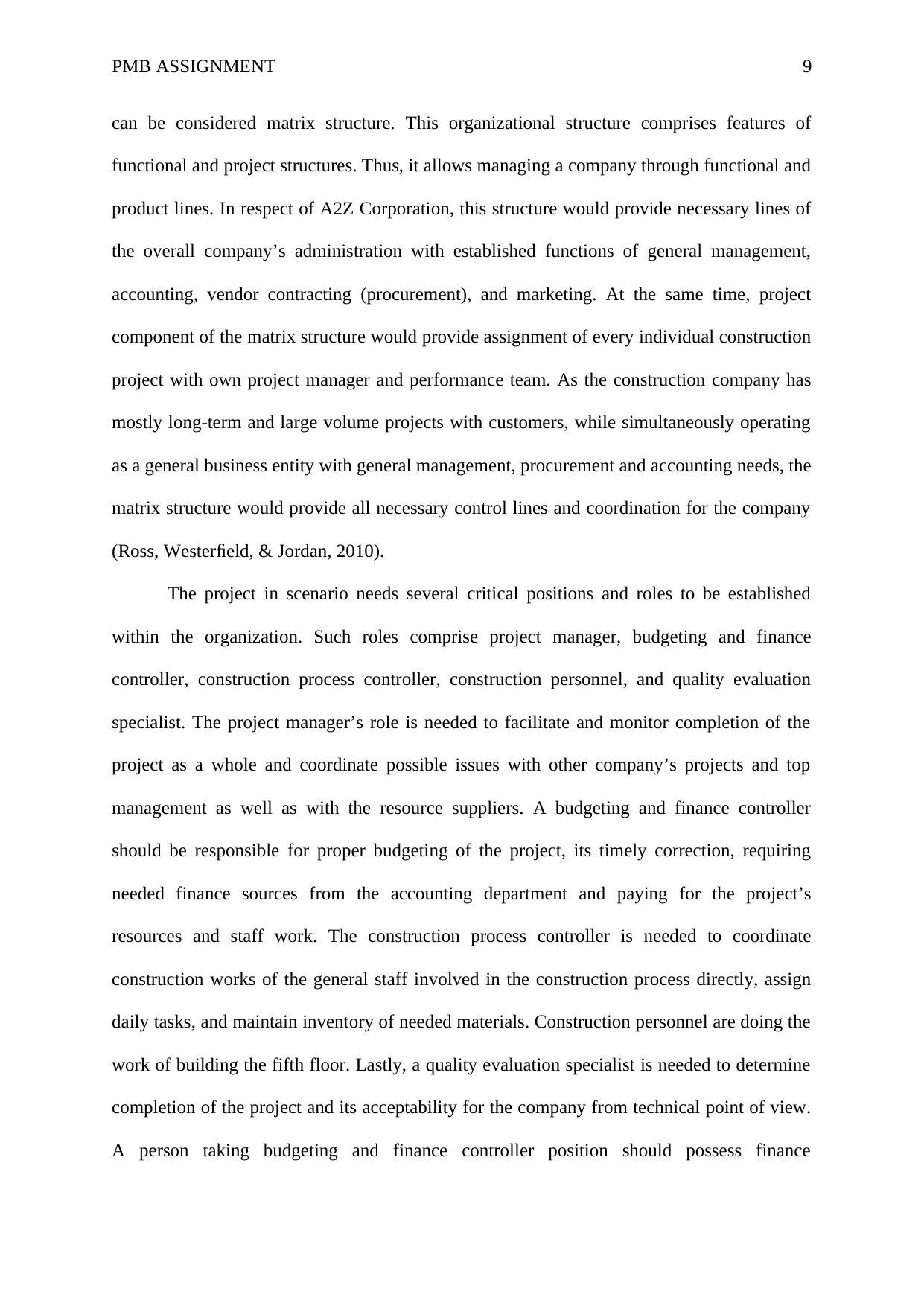
PMB ASSIGNMENT 9
can be considered matrix structure. This organizational structure comprises features of
functional and project structures. Thus, it allows managing a company through functional and
product lines. In respect of A2Z Corporation, this structure would provide necessary lines of
the overall company’s administration with established functions of general management,
accounting, vendor contracting (procurement), and marketing. At the same time, project
component of the matrix structure would provide assignment of every individual construction
project with own project manager and performance team. As the construction company has
mostly long-term and large volume projects with customers, while simultaneously operating
as a general business entity with general management, procurement and accounting needs, the
matrix structure would provide all necessary control lines and coordination for the company
(Ross, Westerfield, & Jordan, 2010).
The project in scenario needs several critical positions and roles to be established
within the organization. Such roles comprise project manager, budgeting and finance
controller, construction process controller, construction personnel, and quality evaluation
specialist. The project manager’s role is needed to facilitate and monitor completion of the
project as a whole and coordinate possible issues with other company’s projects and top
management as well as with the resource suppliers. A budgeting and finance controller
should be responsible for proper budgeting of the project, its timely correction, requiring
needed finance sources from the accounting department and paying for the project’s
resources and staff work. The construction process controller is needed to coordinate
construction works of the general staff involved in the construction process directly, assign
daily tasks, and maintain inventory of needed materials. Construction personnel are doing the
work of building the fifth floor. Lastly, a quality evaluation specialist is needed to determine
completion of the project and its acceptability for the company from technical point of view.
A person taking budgeting and finance controller position should possess finance
can be considered matrix structure. This organizational structure comprises features of
functional and project structures. Thus, it allows managing a company through functional and
product lines. In respect of A2Z Corporation, this structure would provide necessary lines of
the overall company’s administration with established functions of general management,
accounting, vendor contracting (procurement), and marketing. At the same time, project
component of the matrix structure would provide assignment of every individual construction
project with own project manager and performance team. As the construction company has
mostly long-term and large volume projects with customers, while simultaneously operating
as a general business entity with general management, procurement and accounting needs, the
matrix structure would provide all necessary control lines and coordination for the company
(Ross, Westerfield, & Jordan, 2010).
The project in scenario needs several critical positions and roles to be established
within the organization. Such roles comprise project manager, budgeting and finance
controller, construction process controller, construction personnel, and quality evaluation
specialist. The project manager’s role is needed to facilitate and monitor completion of the
project as a whole and coordinate possible issues with other company’s projects and top
management as well as with the resource suppliers. A budgeting and finance controller
should be responsible for proper budgeting of the project, its timely correction, requiring
needed finance sources from the accounting department and paying for the project’s
resources and staff work. The construction process controller is needed to coordinate
construction works of the general staff involved in the construction process directly, assign
daily tasks, and maintain inventory of needed materials. Construction personnel are doing the
work of building the fifth floor. Lastly, a quality evaluation specialist is needed to determine
completion of the project and its acceptability for the company from technical point of view.
A person taking budgeting and finance controller position should possess finance
⊘ This is a preview!⊘
Do you want full access?
Subscribe today to unlock all pages.

Trusted by 1+ million students worldwide
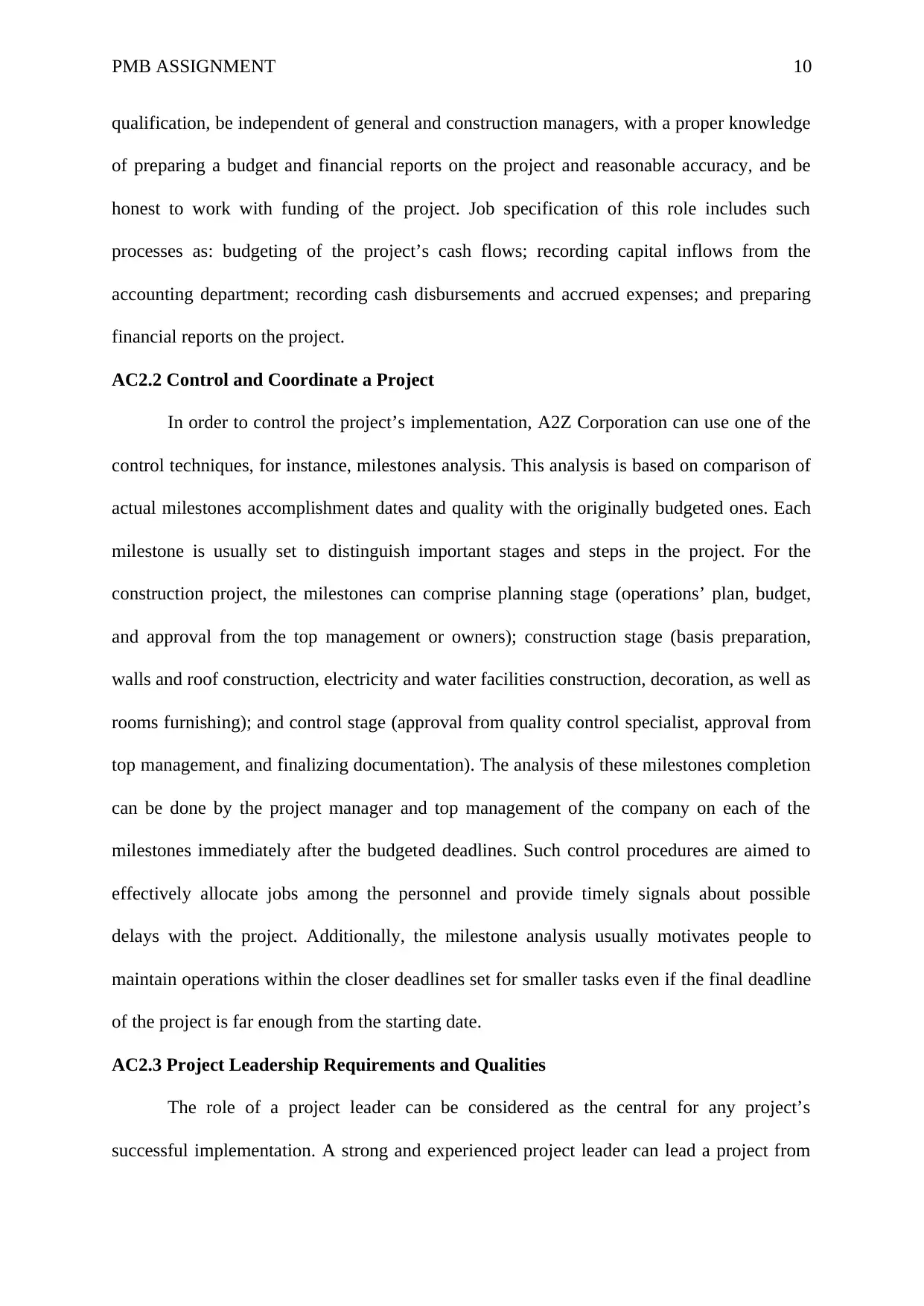
PMB ASSIGNMENT 10
qualification, be independent of general and construction managers, with a proper knowledge
of preparing a budget and financial reports on the project and reasonable accuracy, and be
honest to work with funding of the project. Job specification of this role includes such
processes as: budgeting of the project’s cash flows; recording capital inflows from the
accounting department; recording cash disbursements and accrued expenses; and preparing
financial reports on the project.
AC2.2 Control and Coordinate a Project
In order to control the project’s implementation, A2Z Corporation can use one of the
control techniques, for instance, milestones analysis. This analysis is based on comparison of
actual milestones accomplishment dates and quality with the originally budgeted ones. Each
milestone is usually set to distinguish important stages and steps in the project. For the
construction project, the milestones can comprise planning stage (operations’ plan, budget,
and approval from the top management or owners); construction stage (basis preparation,
walls and roof construction, electricity and water facilities construction, decoration, as well as
rooms furnishing); and control stage (approval from quality control specialist, approval from
top management, and finalizing documentation). The analysis of these milestones completion
can be done by the project manager and top management of the company on each of the
milestones immediately after the budgeted deadlines. Such control procedures are aimed to
effectively allocate jobs among the personnel and provide timely signals about possible
delays with the project. Additionally, the milestone analysis usually motivates people to
maintain operations within the closer deadlines set for smaller tasks even if the final deadline
of the project is far enough from the starting date.
AC2.3 Project Leadership Requirements and Qualities
The role of a project leader can be considered as the central for any project’s
successful implementation. A strong and experienced project leader can lead a project from
qualification, be independent of general and construction managers, with a proper knowledge
of preparing a budget and financial reports on the project and reasonable accuracy, and be
honest to work with funding of the project. Job specification of this role includes such
processes as: budgeting of the project’s cash flows; recording capital inflows from the
accounting department; recording cash disbursements and accrued expenses; and preparing
financial reports on the project.
AC2.2 Control and Coordinate a Project
In order to control the project’s implementation, A2Z Corporation can use one of the
control techniques, for instance, milestones analysis. This analysis is based on comparison of
actual milestones accomplishment dates and quality with the originally budgeted ones. Each
milestone is usually set to distinguish important stages and steps in the project. For the
construction project, the milestones can comprise planning stage (operations’ plan, budget,
and approval from the top management or owners); construction stage (basis preparation,
walls and roof construction, electricity and water facilities construction, decoration, as well as
rooms furnishing); and control stage (approval from quality control specialist, approval from
top management, and finalizing documentation). The analysis of these milestones completion
can be done by the project manager and top management of the company on each of the
milestones immediately after the budgeted deadlines. Such control procedures are aimed to
effectively allocate jobs among the personnel and provide timely signals about possible
delays with the project. Additionally, the milestone analysis usually motivates people to
maintain operations within the closer deadlines set for smaller tasks even if the final deadline
of the project is far enough from the starting date.
AC2.3 Project Leadership Requirements and Qualities
The role of a project leader can be considered as the central for any project’s
successful implementation. A strong and experienced project leader can lead a project from
Paraphrase This Document
Need a fresh take? Get an instant paraphrase of this document with our AI Paraphraser
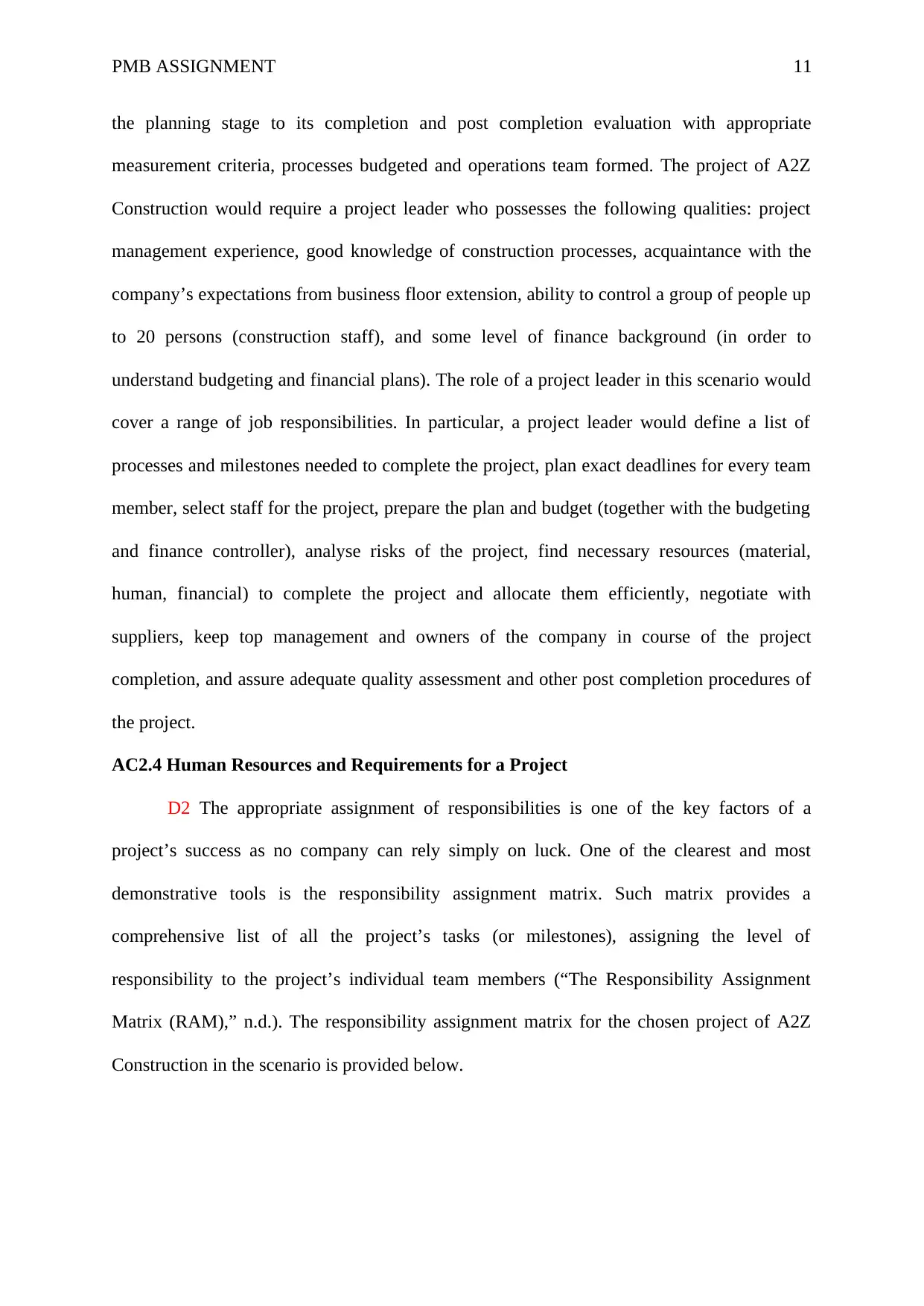
PMB ASSIGNMENT 11
the planning stage to its completion and post completion evaluation with appropriate
measurement criteria, processes budgeted and operations team formed. The project of A2Z
Construction would require a project leader who possesses the following qualities: project
management experience, good knowledge of construction processes, acquaintance with the
company’s expectations from business floor extension, ability to control a group of people up
to 20 persons (construction staff), and some level of finance background (in order to
understand budgeting and financial plans). The role of a project leader in this scenario would
cover a range of job responsibilities. In particular, a project leader would define a list of
processes and milestones needed to complete the project, plan exact deadlines for every team
member, select staff for the project, prepare the plan and budget (together with the budgeting
and finance controller), analyse risks of the project, find necessary resources (material,
human, financial) to complete the project and allocate them efficiently, negotiate with
suppliers, keep top management and owners of the company in course of the project
completion, and assure adequate quality assessment and other post completion procedures of
the project.
AC2.4 Human Resources and Requirements for a Project
D2 The appropriate assignment of responsibilities is one of the key factors of a
project’s success as no company can rely simply on luck. One of the clearest and most
demonstrative tools is the responsibility assignment matrix. Such matrix provides a
comprehensive list of all the project’s tasks (or milestones), assigning the level of
responsibility to the project’s individual team members (“The Responsibility Assignment
Matrix (RAM),” n.d.). The responsibility assignment matrix for the chosen project of A2Z
Construction in the scenario is provided below.
the planning stage to its completion and post completion evaluation with appropriate
measurement criteria, processes budgeted and operations team formed. The project of A2Z
Construction would require a project leader who possesses the following qualities: project
management experience, good knowledge of construction processes, acquaintance with the
company’s expectations from business floor extension, ability to control a group of people up
to 20 persons (construction staff), and some level of finance background (in order to
understand budgeting and financial plans). The role of a project leader in this scenario would
cover a range of job responsibilities. In particular, a project leader would define a list of
processes and milestones needed to complete the project, plan exact deadlines for every team
member, select staff for the project, prepare the plan and budget (together with the budgeting
and finance controller), analyse risks of the project, find necessary resources (material,
human, financial) to complete the project and allocate them efficiently, negotiate with
suppliers, keep top management and owners of the company in course of the project
completion, and assure adequate quality assessment and other post completion procedures of
the project.
AC2.4 Human Resources and Requirements for a Project
D2 The appropriate assignment of responsibilities is one of the key factors of a
project’s success as no company can rely simply on luck. One of the clearest and most
demonstrative tools is the responsibility assignment matrix. Such matrix provides a
comprehensive list of all the project’s tasks (or milestones), assigning the level of
responsibility to the project’s individual team members (“The Responsibility Assignment
Matrix (RAM),” n.d.). The responsibility assignment matrix for the chosen project of A2Z
Construction in the scenario is provided below.
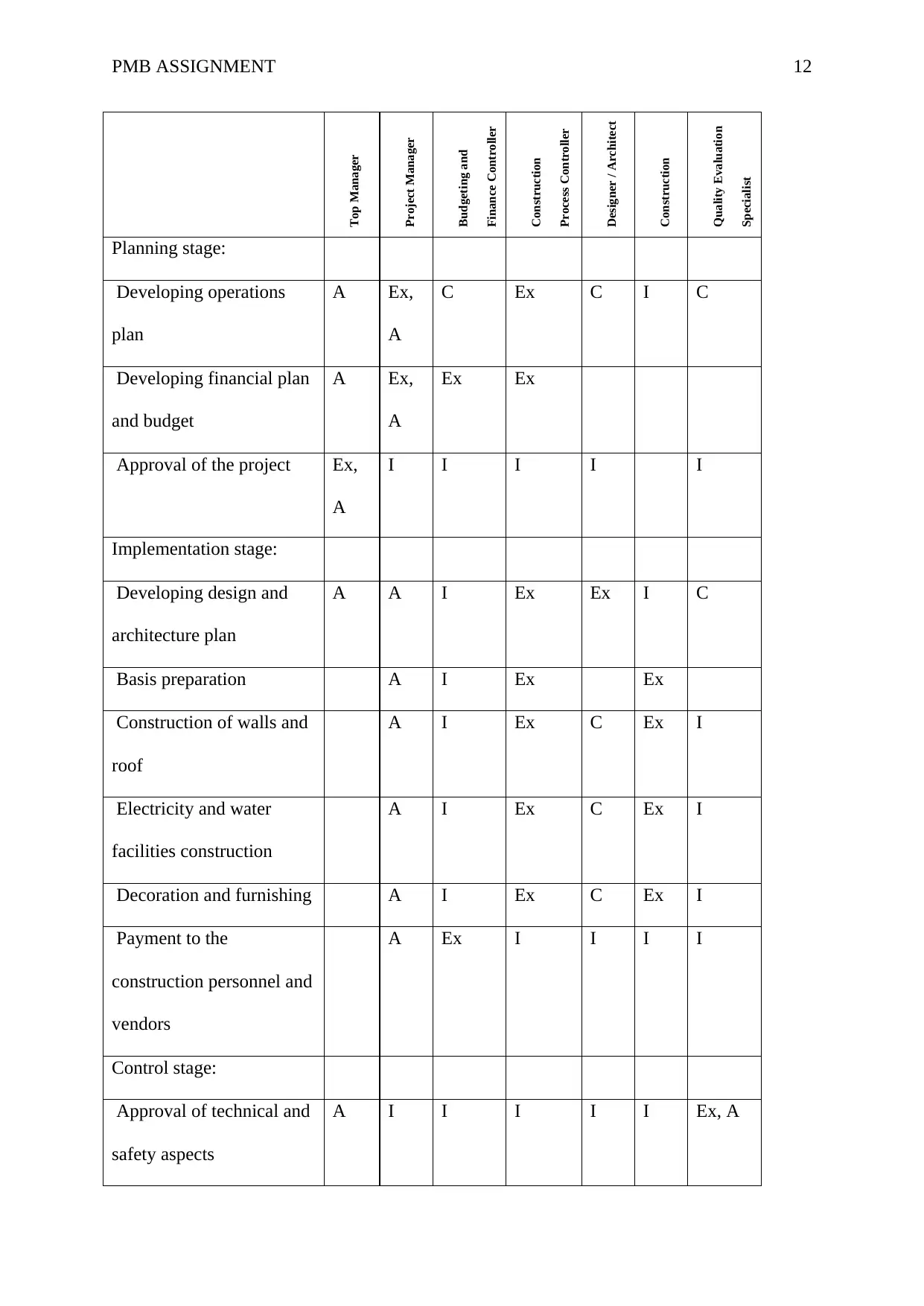
PMB ASSIGNMENT 12
Top Manager
Project Manager
Budgeting and
Finance Controller
Construction
Process Controller
Designer / Architect
Construction
Personnel
Quality Evaluation
Specialist
Planning stage:
Developing operations
plan
A Ex,
A
C Ex C I C
Developing financial plan
and budget
A Ex,
A
Ex Ex
Approval of the project Ex,
A
I I I I I
Implementation stage:
Developing design and
architecture plan
A A I Ex Ex I C
Basis preparation A I Ex Ex
Construction of walls and
roof
A I Ex C Ex I
Electricity and water
facilities construction
A I Ex C Ex I
Decoration and furnishing A I Ex C Ex I
Payment to the
construction personnel and
vendors
A Ex I I I I
Control stage:
Approval of technical and
safety aspects
A I I I I I Ex, A
Top Manager
Project Manager
Budgeting and
Finance Controller
Construction
Process Controller
Designer / Architect
Construction
Personnel
Quality Evaluation
Specialist
Planning stage:
Developing operations
plan
A Ex,
A
C Ex C I C
Developing financial plan
and budget
A Ex,
A
Ex Ex
Approval of the project Ex,
A
I I I I I
Implementation stage:
Developing design and
architecture plan
A A I Ex Ex I C
Basis preparation A I Ex Ex
Construction of walls and
roof
A I Ex C Ex I
Electricity and water
facilities construction
A I Ex C Ex I
Decoration and furnishing A I Ex C Ex I
Payment to the
construction personnel and
vendors
A Ex I I I I
Control stage:
Approval of technical and
safety aspects
A I I I I I Ex, A
⊘ This is a preview!⊘
Do you want full access?
Subscribe today to unlock all pages.

Trusted by 1+ million students worldwide
1 out of 21
Related Documents
Your All-in-One AI-Powered Toolkit for Academic Success.
+13062052269
info@desklib.com
Available 24*7 on WhatsApp / Email
![[object Object]](/_next/static/media/star-bottom.7253800d.svg)
Unlock your academic potential
Copyright © 2020–2025 A2Z Services. All Rights Reserved. Developed and managed by ZUCOL.





